Chobe National Park in Botswana was my third safari. I visited Etosha National Park in Namibia and Kruger National Park in South Africa. The first two safaris featured campsites and lodging within an environment surrounded by electrical fences. Our campsite in Chobe National Park was free ranging. This meant there were no fences between us and lions, leopards, elephants, and whatever might come visit us in the night. This lack of an amenity made for more than one unforgettable experience during my Chobe National Park camping adventure.

The Chobe National Park elephant herd is one of the tops in Africa
Half of the adventure is getting to Chobe National Park
National parks by definition are remote and difficult to get to . Some may see this as a hindrance to visiting, but I feel the adventure of getting there is sometimes just as thrilling as visiting the park itself. Some of my most memorable travel adventures have been getting to remote parks in far flung areas of the world like Thailand, Indonesia, and Borneo.
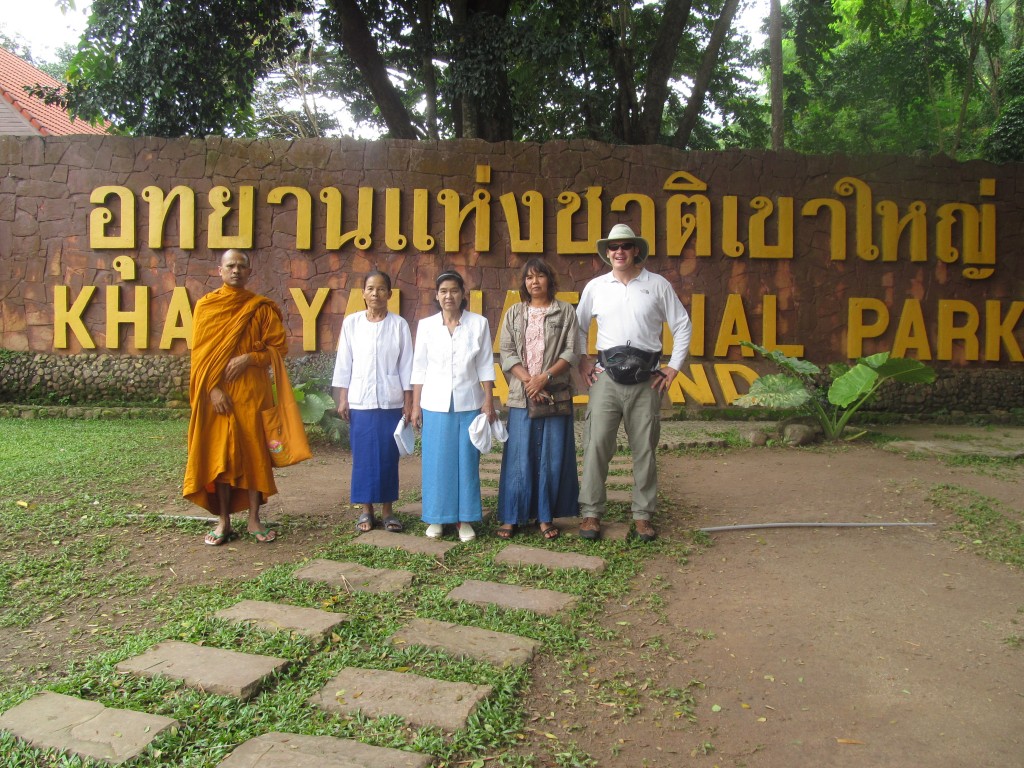
It is quite the adventure getting to Khao Yai National Park in Thailand
Getting to Khao Yai National Park in Thailand required a five hour bus trip from Bangkok to Pak Chong. A shared ride truck/bus from the Park Chong 7-11 took me to the park gates. I was then dismayed to find there was no transport to the park headquarters or the campsite. I asked the ranger how I was supposed to get from the gates to the campsite, and he stuck out his thumb.
Related: Getting to Khao Yai National Park

My silhouette riding on the back of a moto-bike driver on the way to Ujung Kulon National Park in Java, Indonesia.
When I visited Ujung Kulon National Park on the island of Java in Indonesia, the adventure there far trumped my time in the actual park. I took a bus from the outskirts of Jakarta, finding the correct bus was an adventure in of itself, to the remote village of Taman Jaya. From there, I rented a moto bike through tiny seaside villages to the end of the world, or the tip of Java. It was an experience I will never forget.

Chobe National Park camping adventure Botswana begins here
Getting to Chobe National Park was much easier
Readers will be happy to know that getting to Chobe National Park was much easier than the aforementioned trips. The easiest way is to fly into Kasane International Airport. Once in Kasane, just about every hotel and shop sells tours to Chobe. I arrived from Victoria Falls, but it was still fairly easy.

Chobe National Park camping adventure Botswana begins here
I booked my Victoria Falls tour with my guesthouse, Victoria Falls Backpackers. They also sell safaris and shuttles to the park. I booked a two day, one night tour, and a shuttle. The tour cost around $350.00 and the shuttle was an additional $50.00. This is kind of pricy, but I felt satisfied with the tour and services. Victoria Falls Backpackers drove me to the border of Botswana, where the guides from the Chobe tour picked me up after assisting through the border. The assistance was merely pointing to the door. The border crossing into Botswana was effortless. This was the easiest land border crossing I have ever undertaken.

Our tour guide taking us out on the Chobe River
Arriving to Chobe National Park
The truck that picked us up at the border drove us to the tour office where we were provided a buffet breakfast. We had some coffee and then we embarked upon our tour of Chobe National Park. The dock for the boat on the Chobe River was right at the tour office. I was able to leave my backpack at the office and go on the boat tour. The name of our tour company was called Kalahari Tours.

Did not take long until we started seeing wildlife on the Chobe River
The tour consisted of three parts. A boat tour on the Chobe River, a safari through Chobe on the dusty and sandy roads, and an overnight camping trip in a tent. If you book multiple days in Chobe, you basically get the same services again the next day. That is one drawback about safaris is there is nothing much to do and not many activities beyond looking for animals in a car or boat. This is why the camping is a great option as sitting around a campfire in the wilderness never gets old in my opinion.

A safe place to get a Nile crocodile selfie
Chobe National Park camping adventure Botswana boat tour day 1
There were about ten people on the boat tour. They put you in a group with whomever else orders the tour that day. Thankfully, there was no dreaded single person supplement on this tour. I knew right away to expect a different sort of safari as my previous trips. Etosha is basically a desert and while Kruger has a few rivers and ponds, it is pretty dry throughout most of the park. Chobe, on the other hand, is a flood plain and home to bountiful amount of hippos, Nile crocodiles, Cape buffalo, elephants, and water birds.

Everyone is excited as the boat heads towards the national park

Beautiful elephant crossing the Chobe River
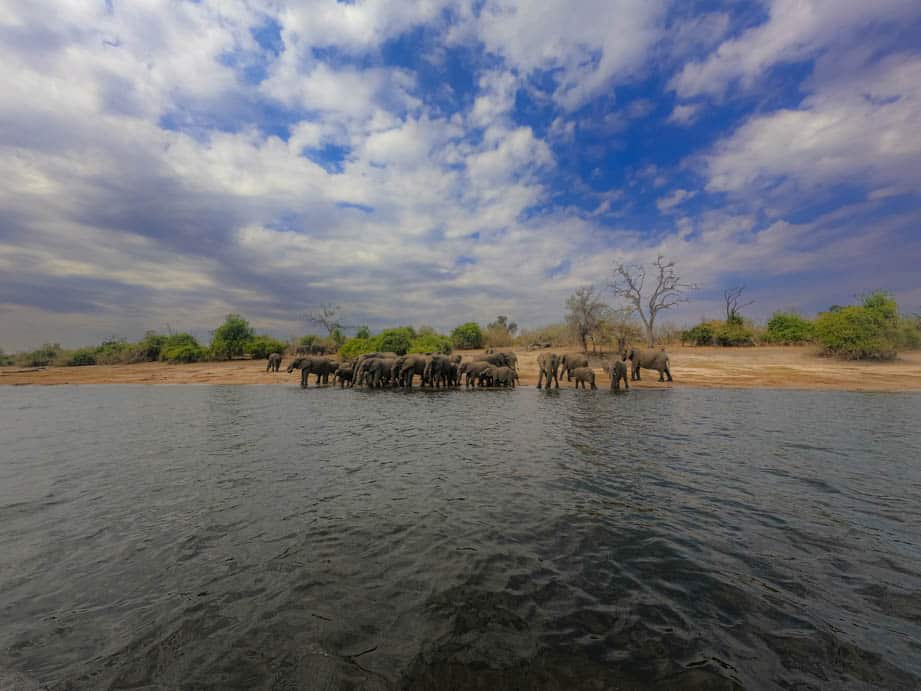
Herd of elephant underneath a gorgeous sky
The birdlife was off the charts in Chobe
I knew there would be more birds in Chobe due to the river, but the amount of waterbirds was astonishing. When not gawking at elephants, Cape buffalo, and Nile crocodiles, we spent hours drifting from one heron to the next with spoonbills, storks, ibises, eagles, darters, and cormorants all over the place as well.

Yellow-billed stork along the Chobe River
I was really excited to see the African spoonbill. One of my favorite U.S. birds is the roseate spoonbill found mainly in southern Florida. Seeing my second variety of spoonbill was quite a treat. There were so many bird species I was seeing for the first time, that it was hard to keep my head straight as I clicked away with my camera. All the guides I experienced on this trip were amazing and knew the name of every species of bird.

African spoonbill spooning the Chobe River bottom
Chobe is world renowned for having the largest African elephant population in the world. From the moment we got in the boat we could see these giants along the river in the distance. In short time, we were a stone’s throw away from these goliaths as they peacefully ate vegetation from the shoreline.

Chobe National Park – Male waterbuck
One new mammal species – Waterbuck
It is always thrilling to see a new species, and I did get a new mammal species to add to my personal list. I had seen so much in Kruger and in Etosha, so most of the animals were not new to me; however, a male waterbuck with a harem of females was a first.

Female lion taken from our safari truck – Chobe National Park

Sleepy lions hanging in the shade

Lions wake up a bit when a herd of elephants stroll by
Chobe National Park camping adventure Botswana vehicle transfer
We returned back to our base and had lunch. Then we transferred to safari trucks and drove through the wilds of Chobe looking for lions, leopards, and whatever else might be out there. We came across some sleepy lions. A pride of lions were hanging out on the edge of the river. Our tour guide said we would return to them later. I was then transferred to another safari vehicle. This was because my new vehicle was going to the campground. All the people I was with throughout the day were day trippers. I said goodbye to my new friends and then met some new friends.

Beautiful lilac breasted roller
Choosing the night camping adventure paid immediate dividends
Our new guide drove us back to the edge of the river where we watched a herd of elephants for about 30 minutes. If you take the day trip, you do not have time to sit and watch animals for such a long time. This was so much fun watching the members of the herd interacting. There were several young elephants, so they of course were adorable.

Lions start to awake as dusk settles in
Time to watch the lions
We then drove back to where the lions were. They were waking up and were beginning the process of heading out for a night hunt. They started to stalk some impalas and giraffes in the distance. The younger ones also found some time to play as they were waking up. Unfortunately, we had to head to our camp as it was getting dark. Even though we did not get to see an actual hunt, I was once again thankful to have this extra time in the park.

We weren’t the only tourists interested in seeing the lions

Pride of lions begin to move out of their afternoon shady spot to start their hunt

Young lions emerge from the bush

We had to get to our camp, so this was my last view of the pride of lions as they headed out for their evening hunt

Giraffe in the foreground of a beautiful Chobe sunset
Camping with leopards and honey badgers
My new tour partners consisted of six college students from Penn St. and Dave and Andrea from England. We had dinner and wine around the campfire and then turned in for the evening. As I mentioned earlier, this camp had no barriers to the animals. Our guide told us that we could use the bathroom at night, but that we needed to bring our light. Sure enough, the wine hit me about an hour later, and I had to use the facilities. I did not go all the way to the bathroom, and just went behind my tent.
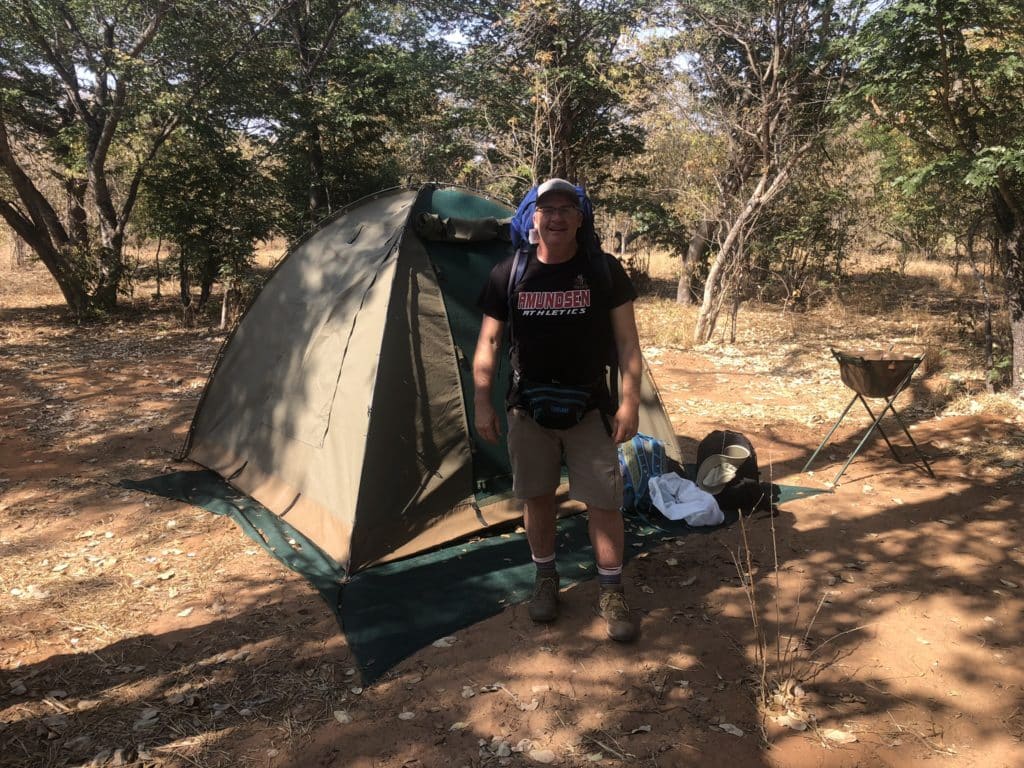
Chobe National Park camping adventure Botswana
I started to hear this strange noise in the distance. It sounded like a combination of a whistle and a growl. I thought it might be a hyena. I started to try and hurry up the process and get back in my tent ASAP. Suddenly, our guide bellowed from his tent asking “IS EVERYONE IN THEIR TENT?” I was not, but I did not want to admit that I was peeing. I was just about done anyway, and in a second I was back in my tent. Our guide then yelled, “there is a leopard approaching the camp, you are safe in your tent.” Now I know what a leopard sounds like at night. I hope to never hear that sound again.

Our guide who saved the night by alerting us of the leopard’s presence
After that scare, I had a difficult time sleeping. I had some adrenaline going through me after my too close call with an approaching leopard. At one point I heard footsteps right outside my tent. Then I heard something messing with our plates and silverware. Eventually, I got to sleep and survived the night. I was so glad to see the sun the next morning. Our guides informed us that the footsteps were probably honey badgers.

Chobe National Park camping adventure Botswana group photo
Great to see daylight
I finally got to sleep. The next day, I was never so happy to see the sunlight. We shared stories of what we heard over coffee and breakfast. I think everyone had a little trouble sleeping after knowing a leopard strolled close by the campground. We asked our guide how close the leopard came, and he guessed perhaps a hundred meters. I sympathized with all the zebras and impalas of the park who go through similar terror every night. I gave a herd of impalas the thumbs up the next morning as we drove out.

Chobe National Park camping adventure Botswana giraffe sunset

Me and the impalas made it through the night
Chobe National Park camping adventure Botswana Day 2
We said goodbye to our camp mates from Pennsylvania, and Dave, Andrea, and I continued day two of the tour. This consisted of more game driving in the park followed by another boat tour. The highlight of the driving part was coming across a male lion who was not too far from our camp. He was at first a little bothered by our presence until he wasn’t. After about five minutes of looking at us, he collapsed in the grass and took a nap.

Animal safaris are not always a success. There are long periods of time consisting of driving through the bush seeing sand, shrubs, trees, and perhaps a ground bird. Then you see a lion and the effort is worthwhile.

Beautiful adult male lion near our camp in Chobe National Park

Male lion officially no longer interested in us
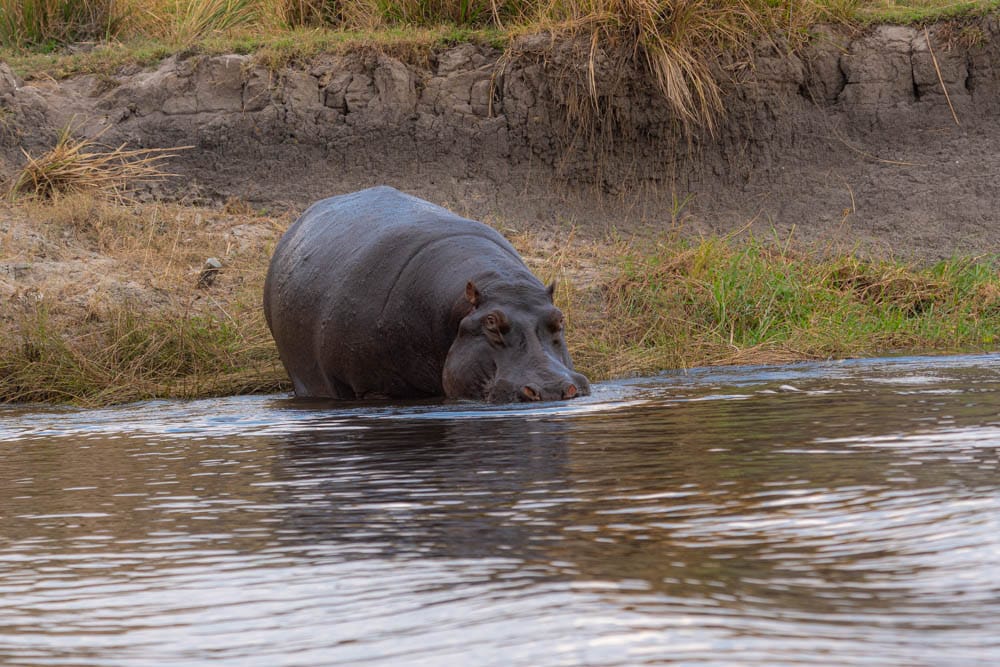
The one animal during my over one month in Africa where our guide made a move to avoid – I think he made a wise choice.
Boat tour day 2
We saw scores of elephants, Cape buffalo, Nile crocodile, hippos, and way more birds. At one point, we startled an adult hippo on an island, and he submerged behind our boat. Our guide revved up the boat and moved away. This was the only time on any of my safaris that any of my guides moved away from an animal. You do not want to mess with an adult hippo.

Beautiful Pied kingfishers along the Chobe River
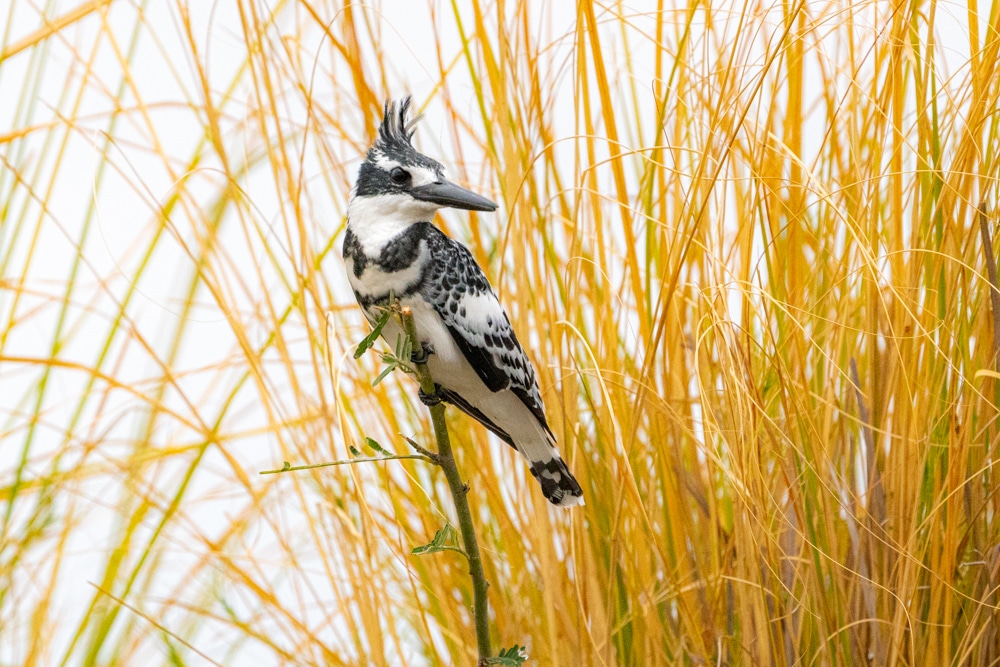
Chobe National Park camping adventure Botswana – Pied kingfisher Chobe River
Kingfishers rule the day
On that same island where the hippo caused us to move, we saw several pied kingfishers. These are black and white kingfishers, and they are very beautiful. I took many many pictures of them. I asked our guide what other kinds of kingfishers are found in the park. He said there are malachite kingfishers and mentioned they are colorful and beautiful. I hoped to see one, but knew it was doubtful as the tour was coming to a close.
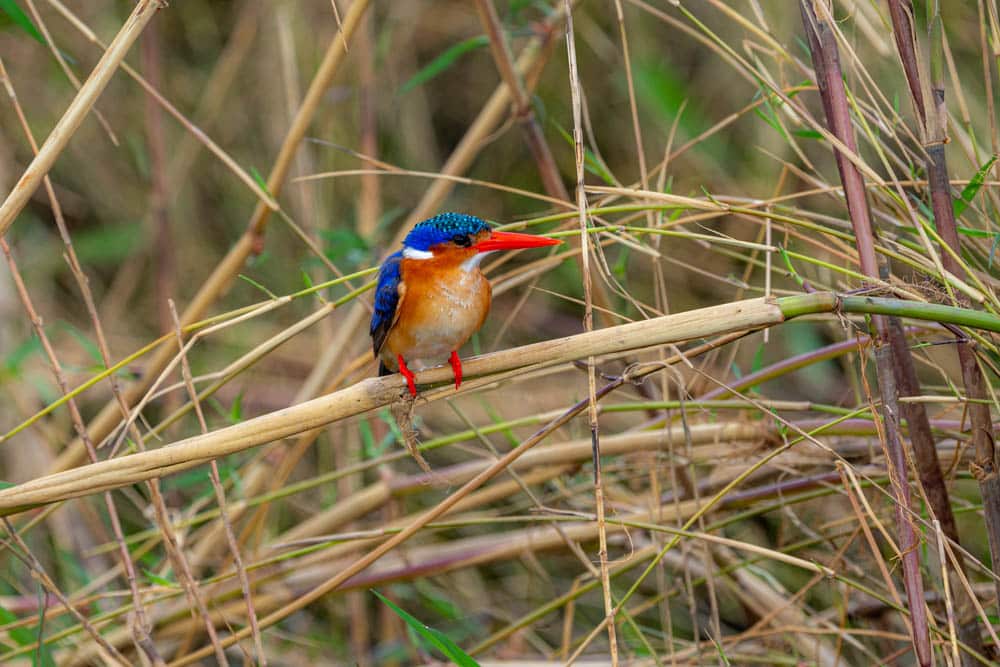
Malachite Kingfisher Botswana
Just as we were about to head back to the dock, our guide excitedly pointed out a malachite kingfisher on the shore. We coasted in to get a closer look and this small bird that looked like a piece of jewelry was perched on a reed at the shoreline. He flew into the water a couple of times trying to catch little minnows. What a great way to end a wonderful tour.
Adventure on!









So happy to see this post from you! Unfortunately Covid took all of us out of circulation for a couple of years– almost 3 years! I’m glad that you now have a permanent job and that you still plan to take trips during breaks. Before I go, I just want to let you know how much I enjoyed the article on your trip to Africa! Definitely exciting!
Thank you Laura. I appreciate you reading it and leaving this comment. Covid was a major bummer. Glad we can finally travel to almost anywhere again.